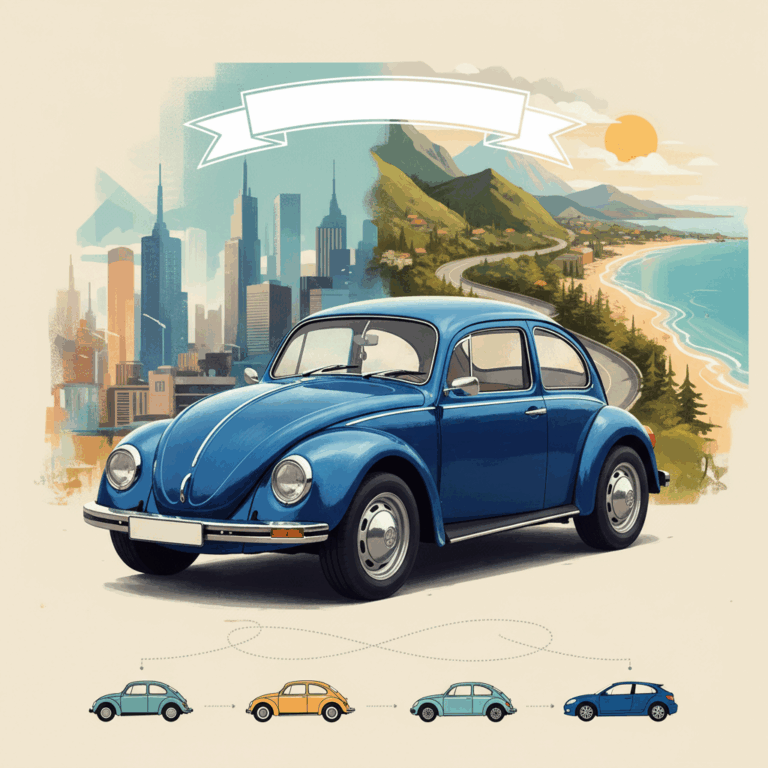History and origin of the Volkswagen Beetle
The Volkswagen Beetle is an iconic car whose creation dates back to the 1930s, with the idea of an affordable vehicle for the German people. Its origin is linked to the vision of Ferry Porsche and Béla Barényi.
Designed to be practical and economical, the Beetle was officially unveiled at the Berlin Motor Show in 1938, marking the beginning of a global automotive legend that endures to this day.
Initial design and presentation in 1938
The Beetle's initial design aimed for a simple, robust, and affordable car for the general population, addressing the need for mass mobility in Germany. Its rounded shape and functional features were innovative.
Introduced in 1938, this vehicle was promoted as "the people's car," designed to be easy to drive and maintain. Its rear engine and aerodynamic body set it apart from other models of the time.
Mass production and early successes
Mass production began in 1945 after World War II, driven by German reconstruction and global demand. The Beetle was noted for its durability and low maintenance costs.
It quickly became a worldwide success, gaining popularity thanks to its reliability and affordability, which laid the foundation for it to become the most produced car in history.
Global popularity and production records
The Volkswagen Beetle achieved unprecedented popularity worldwide due to its practical and economical design. Its mass production made it a global automotive icon.
With over 21 million units manufactured, the Beetle surpassed numerous records and established itself as a cultural phenomenon that transcended borders and generations, becoming an icon of the popular automobile.
Surpassing the Model T and manufacturing numbers
In February 1972, the Beetle surpassed the Ford Model T as the most produced car in history, reaching over 15 million units manufactured. This cemented its place in automotive history.
This record demonstrated its commercial success and global acceptance, attributes that elevated it from an affordable car to a legend in the industry, remaining relevant for several decades.
Nicknames and regional reception
The Beetle was known by different nicknames depending on the region: “Escarabajo” in Argentina, “Vocho” in Mexico, “Fusca” in Brazil and “Cachirulo” in Ecuador, reflecting its great local popularity and popular affection.
These affectionate names also show the cultural adaptation of the vehicle in different markets, where its design and practicality resonated deeply with people.
Cultural significance in the 1960s
During the 1960s, the Beetle became a symbol of the counterculture and the hippie movement in the United States and Europe, representing alternative freedoms and values.
Its simple image and its presence in films and music of the time reinforced its status as a cultural icon beyond its function as a car.
Legacy and modern relaunches
The Volkswagen Beetle left an indelible mark on the automotive industry, with its original production ending in 2003 after more than 21 million units were manufactured. This closure marked the end of an era.
Its influence continued thanks to relaunches, which sought to keep the spirit of the Beetle alive by combining classic design with modern technology, adapting to new audiences and trends.
Total production and end of original manufacturing
By 2003, production of the original Beetle had surpassed 21 million cars, cementing its status as one of the most produced vehicles in history. Its production spanned nearly seven decades.
The cessation of production was a strategic decision in response to changes in the automotive market and environmental regulations, marking the end of an era for this iconic model.
Although production has ended, the Beetle remains a symbol of durability and timeless design, having left a deep mark on global automotive culture.
New Beetle and its impact in the 21st century
In 1998, Volkswagen launched the New Beetle, a modern reinterpretation that revived the iconic shape of the classic model with technological improvements and updated comfort for the 21st century.
This relaunch revitalized interest in the Beetle, attracting both nostalgic fans and new generations, combining retro appeal with advances in safety and performance.
In 2012, a second generation of New Beetle was launched, consolidating its popularity and adapting to contemporary expectations, becoming a renewed symbol of the Beetle legacy.
The Beetle as a cultural icon and collector's item
The Volkswagen Beetle is recognized worldwide for its unique design and cultural significance. Its unmistakable silhouette makes it an automotive icon that inspires admiration.
Over the decades, the Beetle has been more than just a means of transportation, representing values such as simplicity, resilience, and an emotional connection with multiple generations.
Distinctive design and global symbolism
The Beetle's rounded, compact design gives it a distinctive and friendly character, easily recognizable anywhere in the world. This shape has given it a timeless style.
Its symbolism transcends the automotive industry, being associated with freedom, youth and cultural movements, especially during the 1960s, when it was adopted by the counterculture.
Furthermore, its mechanical innovation and ease of maintenance reinforced the image of an accessible car with great personality, winning hearts worldwide.
Cultural connection and value for collectors
The Beetle is a collector's item due to its rich history and iconic design. Enthusiasts value original examples for their authenticity and preservation of classic details.
Its cultural impact has fostered fan communities and dedicated events, where its legacy is celebrated and knowledge about restoration and maintenance is shared.
Today, owning a classic Beetle means owning a piece of automotive and cultural history that continues to inspire new generations of car lovers.







